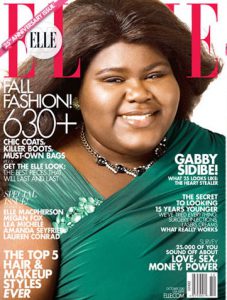by Stephanie Cole
The sexism of the American media can get so bad that I often feel worn down. With reality shows, music videos, advertisements, and fashion magazines producing outrageous material so regularly, I can’t even begin to address it all. When I spent time in England, the ubiquitous advertisements for the television show Footballer’s Wives, and the existence of the so called “Page Three Lovelies” (topless girls on the third page of every issue of The Sun newspaper), reminded me that the problem does not go away outside the United Sates.
 But examining media representation issues internationally is important, both for the sake of awareness and because they can be connected to important issues that affect us in the U.S. So let’s talk India. A recent article in the UK’s Telegraph highlighted the racism discourse that’s emerging as Indian fashion designers like Rohit Bal and Manish Arora gain global prestige. The problem is that European models have been notably preferred over Indian models at these designer’s shows and Indian models are paid significantly less than their white counterparts. Several models have recently spoken out and asked that this brand of racism be addressed.
But examining media representation issues internationally is important, both for the sake of awareness and because they can be connected to important issues that affect us in the U.S. So let’s talk India. A recent article in the UK’s Telegraph highlighted the racism discourse that’s emerging as Indian fashion designers like Rohit Bal and Manish Arora gain global prestige. The problem is that European models have been notably preferred over Indian models at these designer’s shows and Indian models are paid significantly less than their white counterparts. Several models have recently spoken out and asked that this brand of racism be addressed.
Indian model and actress Dipannita Sharma says it’s not just the fashion industry—the entire country of India is obsessed with white skin. “We will take another hundred years to completely get over it,” Sharma said. “The industry doesn’t openly agree that preferring foreign models over Indian models just for the skin tone is racism. It has some kind of fairness obsession.”
 Modelling agent Pranab Awasti is one of many who blame the legacy of British colonialism for the preference of fair skin in India. “Indians in general have that inferiority complex; we have had a hangover about fair skin, since the British left India,” Awasti said.
Modelling agent Pranab Awasti is one of many who blame the legacy of British colonialism for the preference of fair skin in India. “Indians in general have that inferiority complex; we have had a hangover about fair skin, since the British left India,” Awasti said.
As is the case with many prejudices, it seems that women are especially at risk. I’m a bit obsessed with the films of India, popularly known as Bollywood; I think anyone who loves musicals and all around awesomeness should check out Hindi cinema. But while I adore many of the actors and actresses who rule the industry, I can’t help but notice a bit of a complexion disparity.
Most big stars are pretty pale, but some male actors can get away with much deeper skin tones than the actresses they work with. This is not to say that these actresses are not incredibly talented and deserving of their fame, nor do their fair complexions make them any less Indian. But the media that they inhabit is dealing with a particular brand of internal racism, a brand that seems to exist internationally as well.
 This past December, when Bollywood superstar Aishwarya Rai graced the cover of the British Elle, the magazine dramatically lightened her skin. Aishwarya was purportedly outraged, threatening legal action. Elle had a similar problem here in the U.S., when it lightened actress Gabourey Sidibe’s skin on its September cover. Gabby’s cover brings us back home, where our media also deals in gendered racism. The historical source and population may be different from that of India, but our media also associates fairness with feminine beauty. One needs only to consider Hollywood’s most famous African American actors to notice that a complexion disparity is present for women.
This past December, when Bollywood superstar Aishwarya Rai graced the cover of the British Elle, the magazine dramatically lightened her skin. Aishwarya was purportedly outraged, threatening legal action. Elle had a similar problem here in the U.S., when it lightened actress Gabourey Sidibe’s skin on its September cover. Gabby’s cover brings us back home, where our media also deals in gendered racism. The historical source and population may be different from that of India, but our media also associates fairness with feminine beauty. One needs only to consider Hollywood’s most famous African American actors to notice that a complexion disparity is present for women.
As a society we need to closely examine the racism and sexism in play in our media. When Elle seems to think that making an African American actress seem paler is merely part of a “glamorous” photo shoot, it is clear that America too, has an unhealthy “fairness obsession.”
I would call that colorism… not racism.
Not sure what you mean by making the distinction. Race is a social construction, therefore racism is solely defined by things like color. Judging a women’s beauty based on skin tone, especially withing a historically marginalized ethnicity, is a very clear example of racism in practice today.